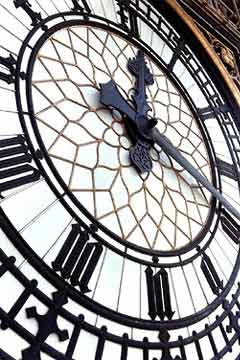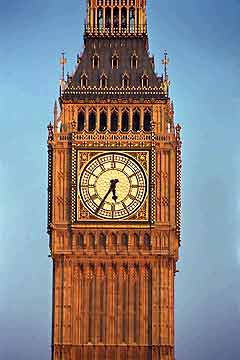The Clock Tower
© 2007
Armchair Travel Co. Ltd. - This page may be used for non-commercial purposes
ONLY!
![]()

[ Play
Narrated and Animated Movie ! ] The clock tower, designed by Charles Barry, is 314 ft tall with 334 steps leading past the clock mechanism room and on up to the belfry, and a further 59 steps up to the lantern at the top. The light in the lantern at the very top of the tower is turned on whenever Parliament is sitting at night. It is known as the Ayrton Light. Although Barry's design is undoubtedly elegant the clock room is so cramped and the shaft so narrow that the clock mechanism had to be re-designed to fit and there was much difficulty in raising the bell. Each of the four clock faces are 23 ft in diameter and are made up of 312 separate pieces of glass. Beneath each face is the inscription in Latin : 'O lord make safe our Queen Victoria'. Half way up the tower is located the Prison Room - originally used to accommodate unruly Members of Parliament, although it has not been used for more than one hundred years.
The clock tower measures 314 ft from the Thames level to the top of the finial, and is about 40 ft square. There are 334 steps which lead from the base to the Belfry, and another 59 steps up to the lantern at the very top. The top of the spire is actually about 9 ins out of the vertical. Lights behind the clock faces are lit whenever Parliament is at work after dark. The Clock Tower is often incorrectly given the name of Big Ben: that name belongs to the hour bell of the clock. This weighs thirteen and a half tons and the hammer alone weighs 4cwt. Twice a day it telegraphs its time automatically to Greenwich Observatory.
The chimes of 'Big Ben' are set to the following lines of Handel's Messiah :
In the lower part of the tower is the Prison room, for such persons as are committed to the custody of the Serjeant at Arms - for instance a member could be detained for misbehaving during a debate. Charles Bradlaugh, for example, was the last Member to be so held in 1880.
The contract was given in 1852 for the clock to be designed by Professor George Airy, Astronomer Royal, and this was eventually completed under the instruction of Edmund Beckett Denison, later 1st Lord Grimthorpe. The clock first went into service on 31 May 1859.
The balance of the clock mechanism is so particularly fine that it is possible to alter the pendulum swing by placing old pennies on it and so slow down or speed up the mechanism to compensate for climatic changes. The addition of one penny causes the clock to gain two-fifths of a second in 24 hours.
[ Virtual
Tour ] [ Main Topics
Index ]



Additional Information on
The Clock Tower
'All through this hour
Lord be my Guide,
That by this power
no foot shall slide'.
Explore-Parliament.net: Advanced Category Search
Keyword Categories:
_Setting_Westminster
_Setting_England
_Clock